Multi-Channel and Omni-Channel Retailing in the Scientific Literature: A Text Mining Approach
Abstract
:1. Introduction
2. Literature Review
3. Methodology
- ✓
- Presenting descriptors’ frequency of occurrence. This refers to the absolute and relative values of the frequency of occurrence for each category of descriptors included in the dictionary, along with the number of documents containing them;
- ✓
- Grouping descriptors on clusters. This sub phase pays attention to arranging in groups, descriptors which are found in the same context or in similar ones. The clusters are graphically represented with different colors.
- ✓
- Link analysis. This refers to highlighting connections among descriptors and finding the strength of those links, by using the Jaccard coefficient.
4. Results and Discussion
5. Conclusions
Author Contributions
Funding
Institutional Review Board Statement
Informed Consent Statement
Data Availability Statement
Conflicts of Interest
References
- Wealthwave—What’s the Biggest Industry in the World. Available online: https://wealthwave.com/anthonystephens/blog/the-biggest-industry-in-the-world (accessed on 14 September 2022).
- Andronie, M.; Lăzăroiu, G.; Ștefănescu, R.; Ionescu, L.; Cocoșatu, M. Neuromanagement decision-making and cognitive algorithmic processes in the technological adoption of mobile commerce apps. Oeconomia Copernic. 2021, 12, 1033–1062. [Google Scholar] [CrossRef]
- Abeam Consulting—The Impact of COVID-19 on the Retail Industry and the Next Actions to be Taken. Available online: https://www.abeam.com/vn/en/topics/insights/covid19_retail (accessed on 14 September 2022).
- International Trade Administration—Impact of COVID Pandemic on eCommerce. Available online: https://www.trade.gov/impact-covid-pandemic-ecommerce (accessed on 14 September 2022).
- Chen, M.; Bashir, R. Role of e-commerce and resource utilization for sustainable business development: Goal of economic recovery after COVID-19. Econ. Chang. Restruct. 2022, 55, 2663–2685. [Google Scholar] [CrossRef]
- Fariselli, P.; Oughton, C.; Picory, C.; Sugden, R. Electronic commerce and the future for SMEs in a global market-place: Networking and public policies. Small Bus. Econ. 1999, 12, 261–275. [Google Scholar] [CrossRef]
- Feindt, S.; Jeffcoate, J.; Chappell, C. Identifying success factors for rapid growth in SME e-commerce. Small Bus. Econ. 2002, 19, 51–62. [Google Scholar] [CrossRef]
- Shah Alam, S.; Ali, M.Y.; Mohd Jani, M.F. An empirical study of factors affecting electronic commerce adoption among SMEs in Malaysia. J. Bus. Econ. Manag. 2011, 12, 375–399. [Google Scholar] [CrossRef] [Green Version]
- Lee, W.J. Unravelling consumer responses to omni-channel approach. J. Theor. Appl. Electron. Commer. Res. 2020, 15, 37–49. [Google Scholar] [CrossRef]
- Schrotenboer, D.; Constantinides, E.; Herrando, C.; de Vries, S. The Effects of Omni-Channel Retailing on Promotional Strategy. J. Theor. Appl. Electron. Commer. Res. 2022, 17, 360–374. [Google Scholar] [CrossRef]
- Vafaei, A.; Yaghoubi, S.; Tajik, J.; Barzinpour, F. Designing a sustainable multi-channel supply chain distribution network: A case study. J. Clean. Prod. 2020, 251, 119628. [Google Scholar] [CrossRef]
- Fan, Y.W.; Miao, Y.F.; Wu, S.C. Customer complaints and service policy in electronic commerce. S. Afr. J. Bus. Manag. 2013, 44, 15–20. [Google Scholar] [CrossRef] [Green Version]
- Moengage—Omnichannel vs. Multichannel Marketing: How Does It Differ? Available online: https://www.moengage.com/learn/omnichannel-vs-multichannel (accessed on 14 September 2022).
- Katai, R. Multi-Channel vs. Omni-Channel: What’s the Difference? Available online: https://robertkatai.com/multichannel-vs-omnichannel/?hilite=omni (accessed on 14 September 2022).
- Ofek, E.; Katona, Z.; Sarvary, M. “Bricks and Clicks”: The Impact of Product Returns on the Strategies of Multichannel Retailers. Mark. Sci. 2011, 30, 42–60. [Google Scholar] [CrossRef]
- Vasiliu, C.; Felea, M.; Albăstroiu, I.; Dobrea, M. Exploring multi-channel shopping behavior towards IT & C products, based on business students opinions. Amfiteatru Econ. J. 2016, 18, 184–198. [Google Scholar]
- Abhishek, V.; Jerath, K.; Zhang, Z.J. Agency selling or reselling? Channel structures in electronic retailing. Manag. Sci. 2016, 62, 2259–2280. [Google Scholar] [CrossRef] [Green Version]
- Brynjolfsson, E.; Hu, Y.; Simester, D. Goodbye pareto principle, hello long tail: The effect of search costs on the concentration of product sales. Manag. Sci. 2011, 57, 1373–1386. [Google Scholar] [CrossRef] [Green Version]
- Rigby, D. The future of shopping. Harv. Bus. Rev. 2011, 89, 65–76. [Google Scholar]
- Cao, L.; Li, L. The impact of cross-channel integration on retailers’ sales growth. J. Retail. 2015, 91, 198–216. [Google Scholar] [CrossRef]
- Weathers, D.; Sharma, S.; Wood, S.L. Effects of online communication practices on consumer perceptions of performance uncertainty for search and experience goods. J. Retail. 2007, 83, 393–401. [Google Scholar] [CrossRef]
- Avery, J.; Steenburgh, T.J.; Deighton, J.; Caravella, M. Adding bricks to clicks: Predicting the patterns of cross-channel elasticities over time. J. Mark. 2012, 76, 96–111. [Google Scholar] [CrossRef]
- Blázquez, M. Fashion shopping in multichannel retail: The role of technology in enhancing the customer experience. Int. J. Electron. Commer. 2014, 18, 97–116. [Google Scholar] [CrossRef] [Green Version]
- Melis, K.; Campo, K.; Breugelmans, E.; Lamey, L. The impact of the multi-channel retail mix on online store choice: Does online experience matter? J. Retail. 2015, 91, 272–288. [Google Scholar] [CrossRef]
- Zhang, M.; Ren, C.; Wang, G.A.; He, Z. The impact of channel integration on consumer responses in omni-channel retailing: The mediating effect of consumer empowerment. Electron. Commer. Res. Appl. 2018, 28, 181–193. [Google Scholar] [CrossRef]
- Yan, Y.; Zhao, R.; Liu, Z. Strategic introduction of the marketplace channel under spillovers from online to offline sales. Eur. J. Oper. Res. 2018, 267, 65–77. [Google Scholar] [CrossRef]
- Tang, F.F.; Xing, X. Will the growth of multi-channel retailing diminish the pricing efficiency of the web? J. Retail. 2001, 77, 319–333. [Google Scholar] [CrossRef]
- Li, Y.; Liu, H.; Lim, E.T.; Goh, J.M.; Yang, F.; Lee, M.K. Customer’s reaction to cross-channel integration in omnichannel retailing: The mediating roles of retailer uncertainty, identity attractiveness, and switching costs. Decis. Support Syst. 2018, 109, 50–60. [Google Scholar] [CrossRef]
- Melacini, M.; Perotti, S.; Rasini, M.; Tappia, E. E-fulfilment and distribution in omni-channel retailing: A systematic literature review. Int. J. Phys. Distrib. Logist. Manag. 2018, 48, 1–34. [Google Scholar] [CrossRef]
- Ancarani, F.; Shankar, V. Price levels and price dispersion within and across multiple retailer types: Further evidence and extension. J. Acad. Mark. 2004, 32, 176–187. [Google Scholar] [CrossRef]
- Bock, G.W.; Lee, J.; Kuan, H.H.; Kim, J.H. The progression of online trust in the multi-channel retailer context and the role of product uncertainty. Decis. Support Syst. 2012, 53, 97–107. [Google Scholar] [CrossRef]
- Wang, W.; Li, G.; Cheng, T.C.E. Channel selection in a supply chain with a multi-channel retailer: The role of channel operating costs. Int. J. Prod. Econ. 2016, 173, 54–65. [Google Scholar] [CrossRef]
- Mishra, R.; Singh, R.K.; Koles, B. Consumer decision-making in Omnichannel retailing: Literature review and future research agenda. Int. J. Consum. Stud. 2021, 45, 147–174. [Google Scholar] [CrossRef]
- Darke, P.R.; Brady, M.K.; Benedicktus, R.L.; Wilson, A.E. Feeling close from afar: The role of psychological distance in offsetting distrust in unfamiliar online retailers. J. Retail. 2016, 92, 287–299. [Google Scholar] [CrossRef]
- Bernon, M.; Cullen, J.; Gorst, J. Online retail returns management: Integration within an omni-channel distribution context. Int. J. Phys. Distrib. Logist. Manag. 2016, 46, 584–605. [Google Scholar] [CrossRef]
- Ha, S.; Stoel, L. Online apparel retailing: Roles of e-shopping quality and experiential e-shopping motives. J. Serv. Manag. 2012, 23, 197–215. [Google Scholar] [CrossRef]
- Carlson, J.; O’Cass, A.; Ahrholdt, D. Assessing customers’ perceived value of the online channel of multichannel retailers: A two country examination. J. Retail. Consum. Serv. 2015, 27, 90–102. [Google Scholar] [CrossRef]
- Jin, M.; Li, G.; Cheng, T.C.E. Buy online and pick up in-store: Design of the service area. Eur. J. Oper. Res. 2018, 268, 613–623. [Google Scholar] [CrossRef]
- Huang, L.; Lu, X.; Ba, S. An empirical study of the cross-channel effects between web and mobile shopping channels. Inf. Manag. 2016, 53, 265–278. [Google Scholar] [CrossRef]
- Zhang, X. Retailers’ multichannel and price advertising strategies. Mark. Sci. 2009, 28, 1080–1094. [Google Scholar] [CrossRef]
- Frasquet, M.; Mollá, A.; Ruiz, E. Identifying patterns in channel usage across the search, purchase and post-sales stages of shopping. Electron. Commer. Res. Appl. 2015, 14, 654–665. [Google Scholar] [CrossRef] [Green Version]
- Anderson, W.P.; Chatterjee, L.; Lakshmanan, T.R. E-commerce, transportation, and economic geography. Growth Chang. 2003, 34, 415–432. [Google Scholar] [CrossRef]
- Cai, Y.J.; Lo, C.K. Omni-channel management in the new retailing era: A systematic review and future research agenda. Int. J. Prod. Econ. 2020, 229, 107729. [Google Scholar] [CrossRef]
- Badrinarayanan, V.; Becerra, E.P.; Kim, C.H.; Madhavaram, S. Transference and congruence effects on purchase intentions in online stores of multi-channel retailers: Initial evidence from the US and South Korea. J. Acad. Mark. Sci. 2012, 40, 539–557. [Google Scholar] [CrossRef]
- Basak, S.; Basu, P.; Avittathur, B.; Sikdar, S. A game theoretic analysis of multichannel retail in the context of “showrooming”. Decis. Support Syst. 2017, 103, 34–45. [Google Scholar] [CrossRef]
- Lewis, J.; Whysall, P.; Foster, C. Drivers and technology-related obstacles in moving to multichannel retailing. Int. J. Electron. Commer. 2014, 18, 43–68. [Google Scholar] [CrossRef] [Green Version]
- Wagner, G.; Schramm-Klein, H.; Steinmann, S. Online retailing across e-channels and e-channel touchpoints: Empirical studies of consumer behavior in the multichannel e-commerce environment. J. Bus. Res. 2020, 107, 256–270. [Google Scholar] [CrossRef]
- Jocevski, M.; Arvidsson, N.; Miragliotta, G.; Ghezzi, A.; Mangiaracina, R. Transitions towards omni-channel retailing strategies: A business model perspective. Int. J. Retail Distrib. Manag. 2019, 47, 78–93. [Google Scholar] [CrossRef]
- Galipoglu, E.; Kotzab, H.; Teller, C.; Hüseyinoglu, I.Ö.Y.; Pöppelbuß, J. Omni-channel retailing research–state of the art and intellectual foundation. Int. J. Phys. Distrib. Logist. Manag. 2018, 48, 365–390. [Google Scholar] [CrossRef]
- Xu, X.; Jackson, J.E. Examining customer channel selection intention in the omni-channel retail environment. Int. J. Prod. Econ. 2019, 208, 434–445. [Google Scholar] [CrossRef]
- Cicea, C.; Marinescu, C.; Albu, C.F.; Balan, P.D. Applying bibliometric mapping and clustering on research regarding biomass related innovation. In Proceedings of the 33rd IBIMA Conference, Granada, Spain, 11 April 2019. [Google Scholar]
- Cicea, C.; Ciocoiu, C.N.; Marinescu, C. Exploring the Research Regarding Energy-Economic Growth Relationship. Energies 2021, 14, 2661. [Google Scholar] [CrossRef]
- Cicea, C.; Marinescu, C. Bibliometric analysis of foreign direct investment and economic growth relationship. A research agenda. J. Bus. Econ. Manag. 2021, 22, 445–466. [Google Scholar] [CrossRef]
- Cicea, C.; Lefteris, T.; Marinescu, C.; Popa, Ș.C.; Albu, C.F. Applying Text Mining Technique on Innovation-Development Relationship: A Joint Research Agenda. Econ. Comput. Econ. Cybern. Stud. Res. 2021, 55, 5–21. [Google Scholar] [CrossRef]
- Silver, C. QDA Miner (with Wordstat and Simstat). J. Mix. Methods Res. 2014, 9, 386–387. [Google Scholar] [CrossRef]
- González-Loureiro, M.; Kiessling, T.; Dabic, M. Acculturation and overseas assignments: A review and a research agenda. Int. J. Intercult. Relat. 2015, 49, 239–250. [Google Scholar] [CrossRef]
- Yelland, P. An Introduction to Correspondence Analysis. Math. J. 2010, 12, 86–109. [Google Scholar] [CrossRef]
- Greenacre, M. Correspondence Analysis. In International Encyclopedia of Education; Elsevier Ltd.: Amsterdam, The Netherlands, 2010; pp. 103–111. [Google Scholar] [CrossRef]
- Dabic, M.; González-Loureiro, M.; Furrer, O. Research on the strategy of multinational enterprises: Key approaches and new avenues. BRQ Bus. Res. Q. 2014, 17, 129–148. [Google Scholar] [CrossRef] [Green Version]
- Greenacre, M. Interdisciplinary Statistics—Correspondence Analysis in Practice, 2nd ed.; Taylor & Francis Group: Boca Raton, FL, USA, 2007; pp. 137–196. [Google Scholar]
- Khangar, N.; Kamalja, K.K. Multiple Correspondence Analysis and its applications. Electron. J. Appl. Stat. Anal. 2017, 10, 432–462. [Google Scholar] [CrossRef]
- López-Duarte, C.; González-Loureiro, M.; Vidal-Suárez, M.M.; González-Díaz, B. International strategic alliances and national culture: Mapping the field and developing a research agenda. J. World Bus. 2016, 51, 511–524. [Google Scholar] [CrossRef]
- Massarani, L.; Neves, L.F.F. Communicating the “Race” for the COVID-19 Vaccine: An Exploratory Study in Newspapers in the United States, the United Kingdom, and Brazil. Front. Commun. 2021, 6, 643895. [Google Scholar] [CrossRef]
- Cogburn, D. Analyzing trends and topics in internet governance and cybersecurity debates found in twelve years of IGF transcripts. In Proceedings of the 52nd Hawaii International Conference on System Sciences, Maui, HI, USA, 8–11 January 2019; pp. 902–911. [Google Scholar]

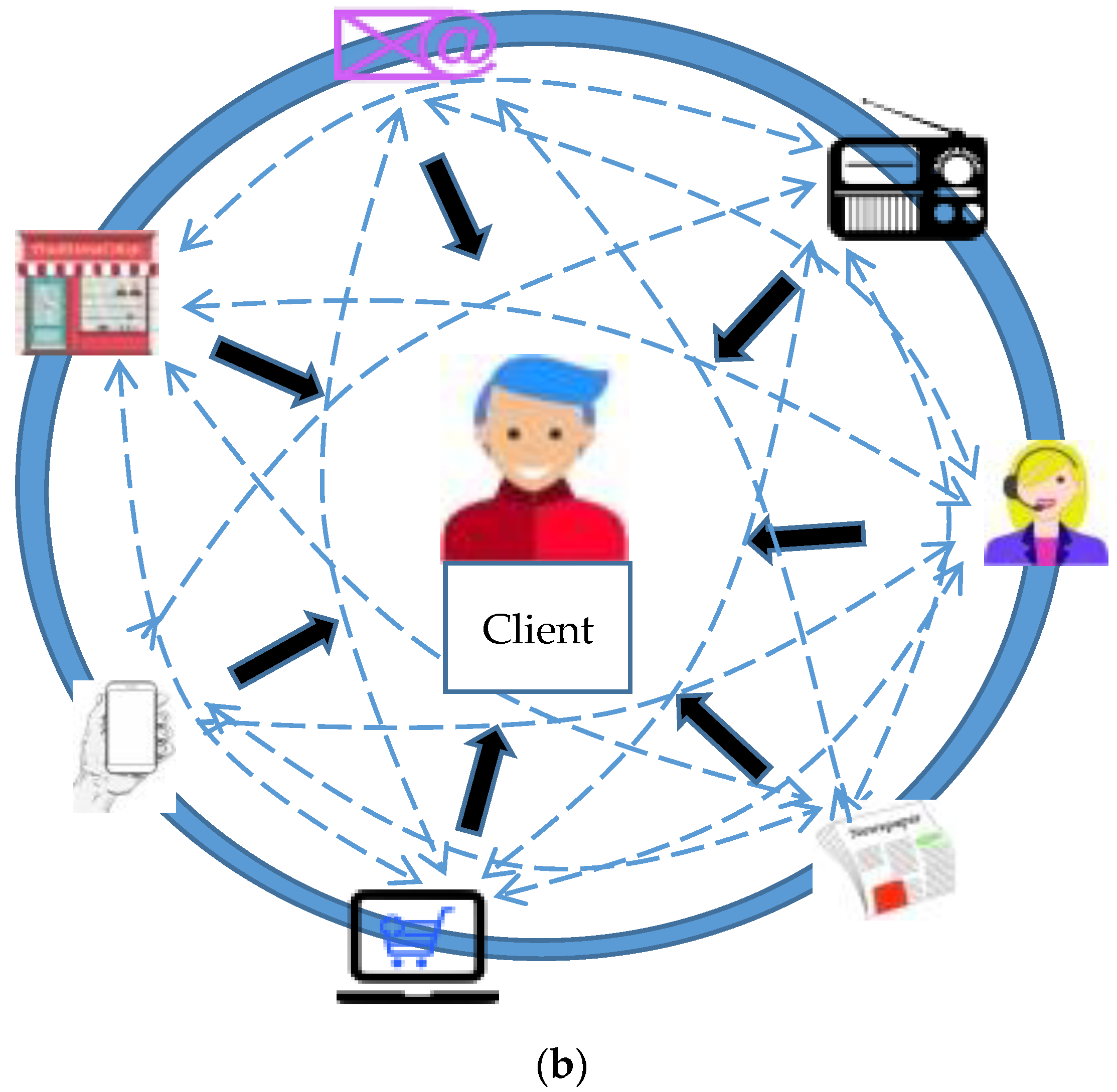

 -Asia,
-Asia,  -America and
-America and  -Europe). Source: Authors.
-Europe). Source: Authors.
 -Asia,
-Asia,  -America and
-America and  -Europe). Source: Authors.
-Europe). Source: Authors.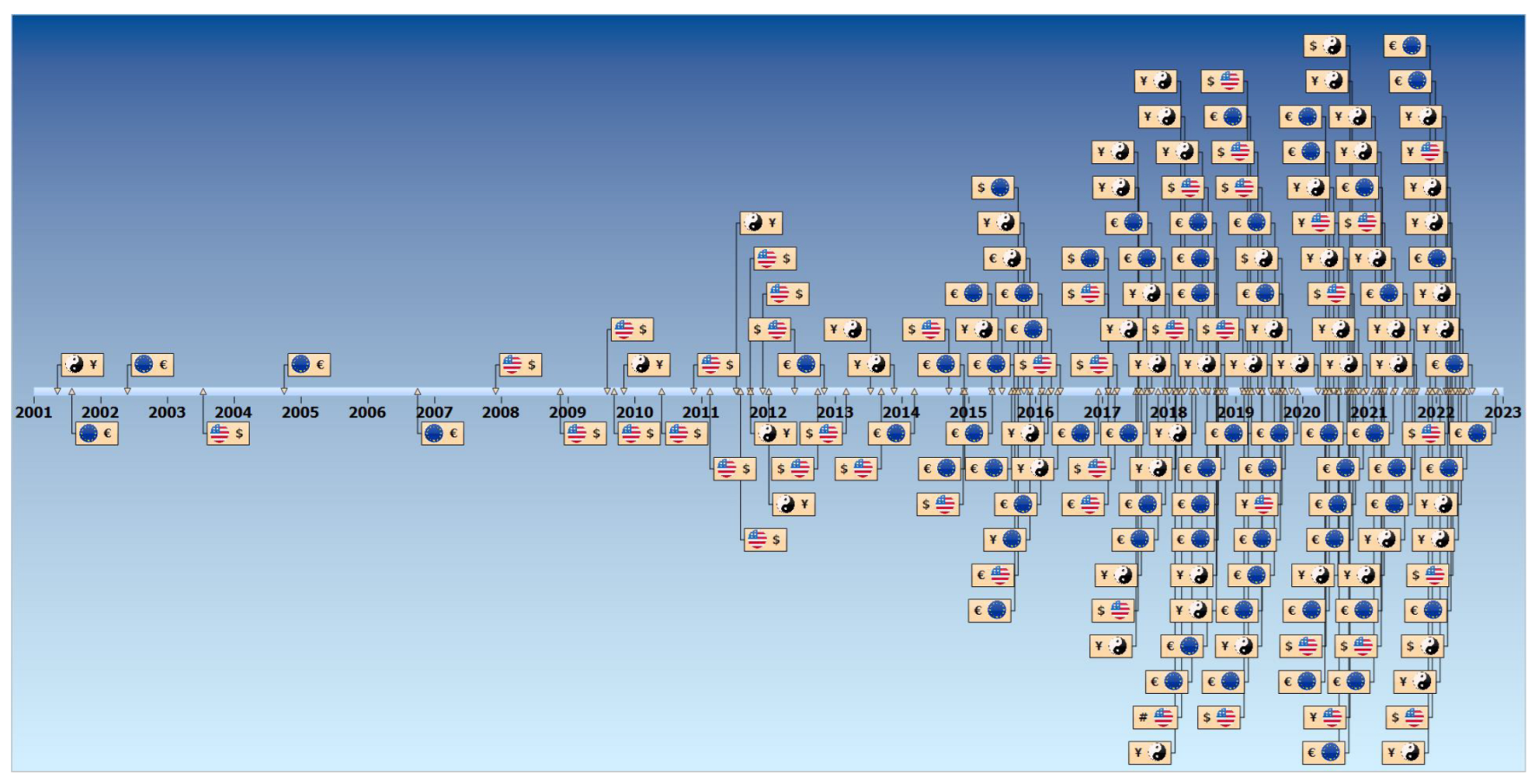
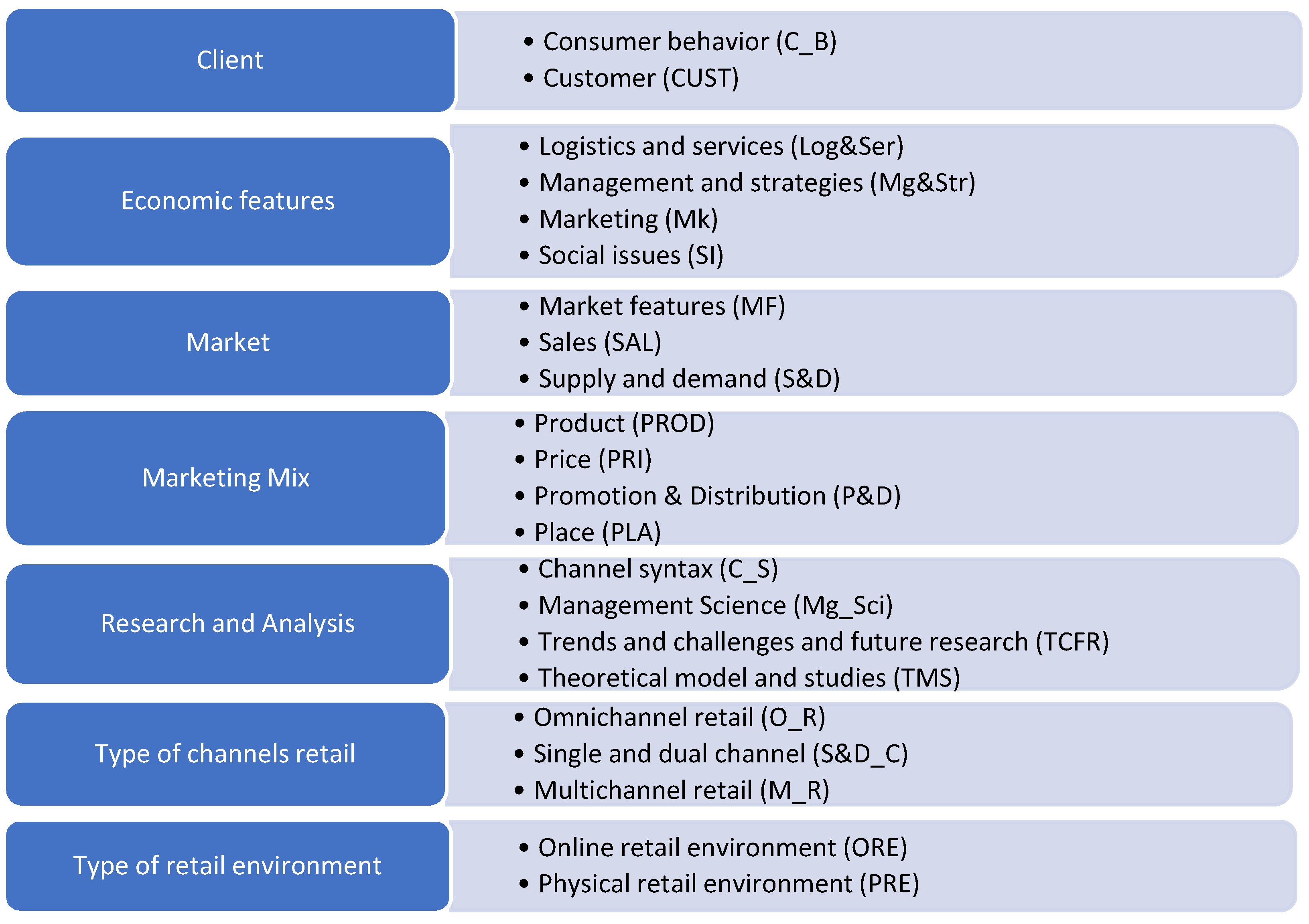
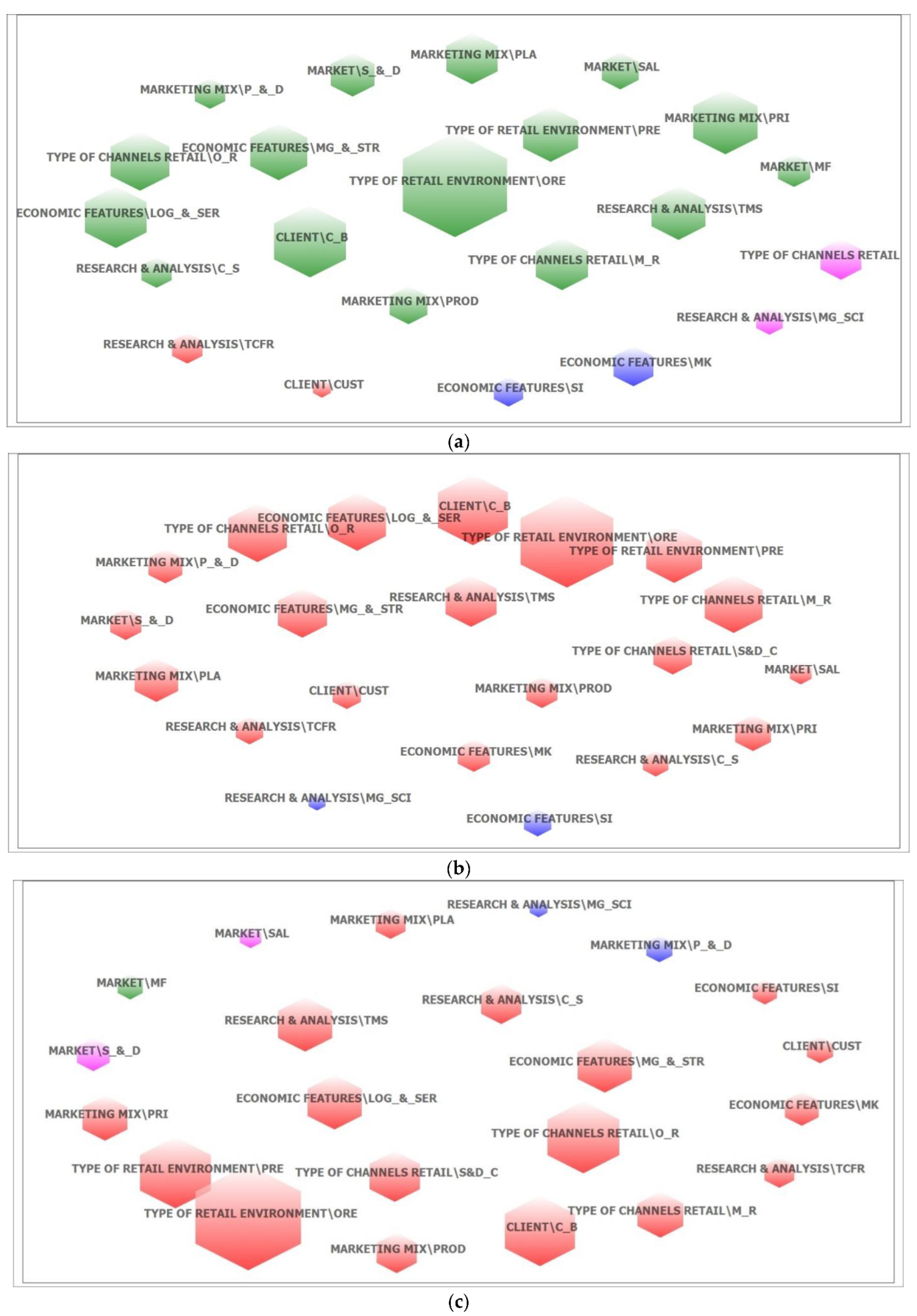


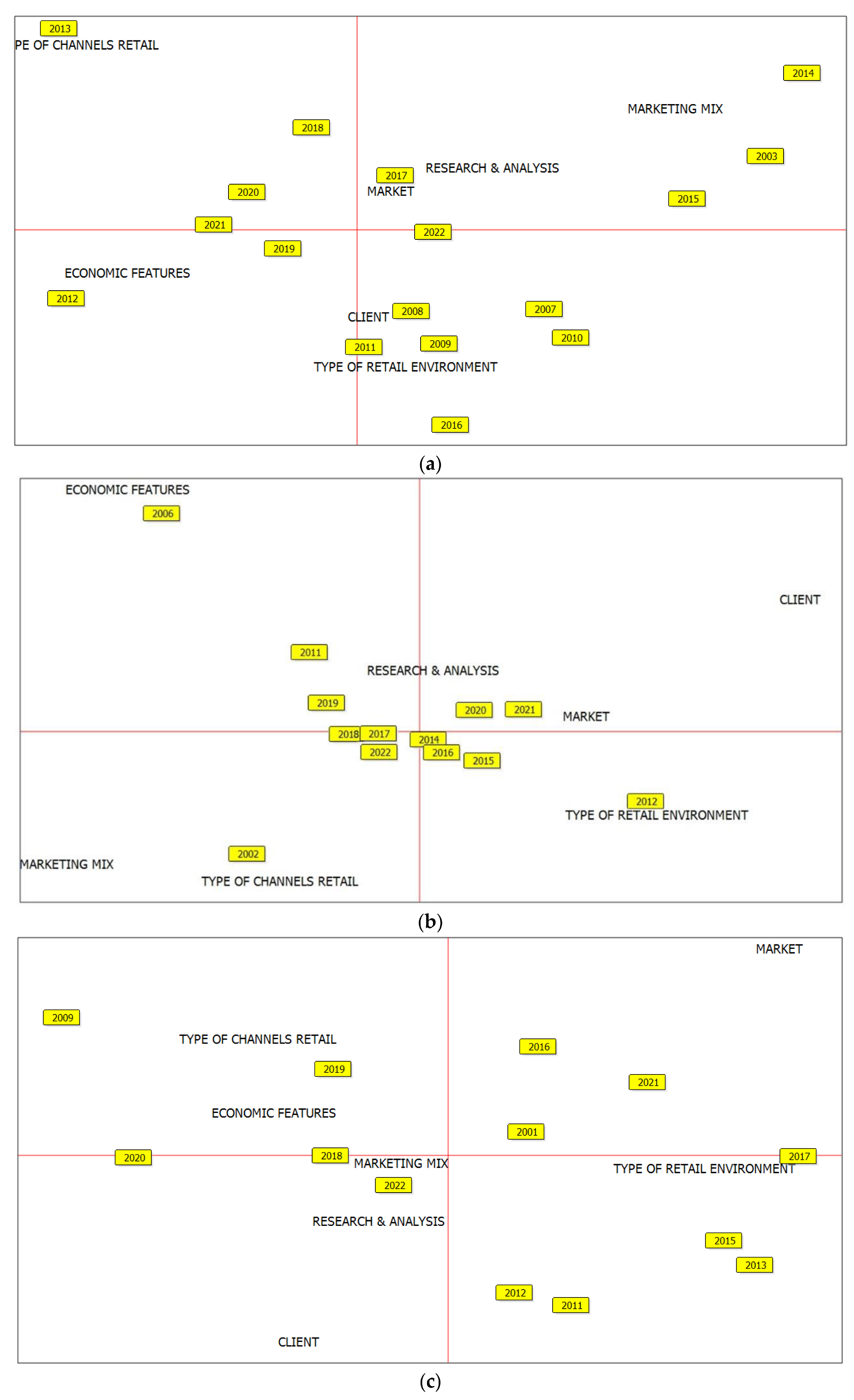
| Authors | Number of Citations | Topic |
|---|---|---|
| Abhishek, Jerath & Zhang (2016) [17] | 319 | The paper compares two ways e-tailers (online retailers) have to allow manufacturers’ access to their customers (agency selling versus conventional selling). |
| Brynjolfsson, Hu & Simester (2011) [18] | 295 | The authors analyze data from a multichannel retailer in order to compare internet and traditional channels in terms of sales distribution. |
| Rigby (2011) [19] | 266 | The authors designed the Random Forest prediction model for the Indian online shopping market. |
| Ofek, Katona & Sarvary (2011) [15] | 253 | The paper discusses differences regarding pricing strategies and physical store assistance levels when using dual channel strategy. |
| Cao & Li (2015) [20] | 241 | This is an analysis on the impact of channel integration on a firm sales growth using a novel framework proposed by authors. |
| Weathers, Sharma & Wood (2007) [21] | 238 | The authors examine three online retailer communication practices and reveal on consumer perceptions of product performance uncertainty. |
| Avery et al. (2012) [22] | 236 | The analysis focuses on the effects appeared when introducing a new retail store channel to the existing direct channels. |
| Blázquez (2014) [23] | 180 | Focusing on fashion industry, the paper deals with multichannel shopping experiences and their influence on consumers’ perceptions and motivations. |
| Melis et al. (2015) [24] | 159 | The study investigates the drivers supporting the online shopping for groceries and changes that may affects them when customers gain experience. |
| Zhang et al. (2018) [25] | 125 | The authors connect channel integration strategy to client empowerment and use a specific framework to confirm the positive link between them. |
| Yan, Zhao & Liu (2018) [26] | 122 | The analysis focuses on the implications of introducing the marketplace channel and its effects on e-tailers and manufacturers. |
| Tang & Xing (2001) [27] | 117 | The study envisages two categories of retailers (traditional online retailers and pure Internet retailers) in order to study their pricing behaviour. |
| Li et al. (2018) [28] | 112 | Dealing with the customers reaction on cross-channel integration, the authors demonstrates the role of uncertainty, identity attractiveness, and switching costs in shaping this reaction. |
| Melacini et al. (2018) [29] | 106 | The paper applies a systematic literature review methodology in order to highlight specific features related to e-fulfilment and distribution associated with choosing omni-channel retailing |
| Ancarani & Shankar (2004) [30] | 103 | The study envisages three categories of retailers: pure-play Internet, bricks-and-mortar (traditional), and bricks-and-clicks (multichannel) retailers, in order to study their pricing behaviour. |
| Bock et al. (2012) [31] | 100 | Considering different product types and the multi-channel retailing context, the authors try to reveal what influences the online trust. |
| Wang, Li & Cheng (2016) [32] | 91 | The analysis explains there is a gap between the online and offline channels’ operating costs which affects the retailer’s choice on channel selection. |
| Mishra, Singh & Koles (2021) [33] | 82 | The literature review in this paper concentrates on consumer behaviour in omni-channel retailing, creating a holistic radiography of this theme in the scientific field. |
| Darke et al. (2016) [34] | 81 | The analysis presents insights on the online trust as influenced by psychological distance. |
| Bernon, Cullen & Gorst (2016) [35] | 81 | The paper concerns retail returns management process and addresses the emergent managerial implications of omni-channel retail returns. |
| Ha & Stoel (2012) [36] | 81 | The paper deals with e-shopping dimensions and factors and discuss their influence on the customers intention and satisfaction as shopping outcomes. |
| Carlson, O’Cass & Ahrholdt (2015) [37] | 76 | This paper focuses on customer perceived online channel value and how clients perceptions affect satisfaction and channel loyalty. |
| Jin, Li & Cheng (2018) [38] | 74 | The analysis discusses the buy-online-pick-up-in-store method and designs a theoretical model for the case of a physical retailer. |
| Huang, Lu & Ba (2016) [39] | 72 | The paper discusses web versus mobile shopping and the consumers shift from one to another. |
| Zhang (2009) [40] | 71 | The author brings into attention the pricing strategy adoption for traditional retailers choosing a multi-channel strategy. |
| Frasquet, Mollá & Ruiz (2015) [41] | 69 | Channel choice is brought into attention and presented as unique for each stage of the shopping process (search, purchase and post-sales activities). |
| Anderson, Chatterjee & Lakshmanan (2003) [42] | 68 | The authors identify possible spatial impacts of e-retailing development and try to put into question the substitution between e-retail and traditional retail. |
| Cai & Lo (2020) [43] | 66 | The analysis consists in a systematic literature review on omni-channel management. |
| Badrinarayanan et al. (2012) [44] | 60 | The authors aim to develop and validate a framework for investigating purchase intentions in online stores of multi-channel retailers. |
| Basak et al. (2017) [45] | 59 | The authors analyze the effect of showrooming on the online and traditional retailers sales. |
| Lewis, Whysall & Foster (2014) [46] | 58 | The paper identifies obstacles faced by retailers when moving to multi-channel retailing and designs a framework in this regard. |
| Wagner, Schramm-Klein & Steinmann (2020) [47] | 57 | This research paper combines the results of an online survey and an experimental study to substantiate salient features of online retailing. |
| Jocevski et al. (2019) [48] | 57 | The research paper links omni-channel strategies to digitalization in a business model context. |
| Galipoglu et al. (2018) [49] | 56 | The analysis focuses on the scientific literature on logistics and supply chain management in omni-channel strategies. |
| Xu & Jackson (2019) [50] | 49 | The authors discuss the omni-channel features that influence clients’ perception. |
| Category of Descriptors | Descriptors | America | Europe | Asia and Australia | ||||||
|---|---|---|---|---|---|---|---|---|---|---|
| Frequency | No of Cases | TF/IDF * | Frequency | No of Cases | TF/IDF * | Frequency | No of Cases | TF/IDF * | ||
| Type of retail environment | Online retail environment (ORE) | 1971 | 44 | 19.2 | 3095 | 65 | 60.6 | 3581 | 58 | 52.7 |
| Physical retail environment (PRE) | 551 | 39 | 34.2 | 1123 | 64 | 29.6 | 1632 | 60 | 0 | |
| Marketing mix | Product (PROD) | 266 | 39 | 16.5 | 364 | 54 | 36.4 | 518 | 51 | 36.6 |
| Price (PRI) | 761 | 30 | 134 | 487 | 27 | 195.4 | 640 | 41 | 105.8 | |
| Promotion & Distribution (P&D) | 164 | 21 | 54.3 | 400 | 49 | 56.9 | 218 | 42 | 33.8 | |
| Place (PLA) | 468 | 43 | 9.2 | 687 | 61 | 32.4 | 286 | 53 | 15.4 | |
| Research and Analysis | Channel syntax (C_S) | 164 | 26 | 39.1 | 239 | 42 | 50 | 525 | 44 | 70.7 |
| Management Science (Mg_Sci) | 126 | 26 | 30 | 110 | 32 | 36 | 99 | 29 | 31.3 | |
| Theoretical model and studies (TMS) | 534 | 40 | 27.3 | 936 | 64 | 24.6 | 939 | 58 | 13.8 | |
| Trends and challenges and future research (TCFR) | 169 | 41 | 6.8 | 268 | 57 | 20.5 | 292 | 54 | 13.4 | |
| Type of channels retail | Multi-channel retail (M_R) | 492 | 35 | 53.7 | 1230 | 57 | 94.3 | 689 | 53 | 37.1 |
| Omni-channel retail (O_R) | 619 | 25 | 158 | 1148 | 49 | 163.4 | 1696 | 42 | 262.7 | |
| Single and dual channel (S&D_C) | 297 | 30 | 52.3 | 564 | 39 | 136.2 | 820 | 50 | 64.9 | |
| Market | Market features (MF) | 184 | 24 | 50.2 | 89 | 30 | 31.6 | 208 | 28 | 68.8 |
| Supply and demand (S&D) | 338 | 22 | 105 | 337 | 34 | 101.4 | 337 | 29 | 106.4 | |
| Sales (SAL) | 243 | 32 | 36 | 171 | 36 | 47.2 | 154 | 40 | 27.1 | |
| Client | Customer (CUST) | 56 | 19 | 21 | 298 | 34 | 89.7 | 219 | 35 | 51.3 |
| Consumer behavior (C_B) | 938 | 39 | 58.3 | 1822 | 62 | 73.1 | 1586 | 59 | 11.6 | |
| Economic features | Management and strategies (Mg&Str) | 588 | 42 | 17.6 | 873 | 62 | 35 | 939 | 57 | 20.9 |
| Logistics and services (Log&Ser) | 694 | 33 | 93.5 | 1227 | 61 | 57.9 | 950 | 53 | 51.2 | |
| Marketing (Mk) | 290 | 33 | 39.1 | 377 | 47 | 60.5 | 361 | 51 | 25.5 | |
| Social issues (SI) | 160 | 20 | 56.3 | 272 | 36 | 75.1 | 198 | 38 | 39.3 | |
Disclaimer/Publisher’s Note: The statements, opinions and data contained in all publications are solely those of the individual author(s) and contributor(s) and not of MDPI and/or the editor(s). MDPI and/or the editor(s) disclaim responsibility for any injury to people or property resulting from any ideas, methods, instructions or products referred to in the content. |
© 2022 by the authors. Licensee MDPI, Basel, Switzerland. This article is an open access article distributed under the terms and conditions of the Creative Commons Attribution (CC BY) license (https://creativecommons.org/licenses/by/4.0/).
Share and Cite
Cicea, C.; Marinescu, C.; Banacu, C.S. Multi-Channel and Omni-Channel Retailing in the Scientific Literature: A Text Mining Approach. J. Theor. Appl. Electron. Commer. Res. 2023, 18, 19-36. https://doi.org/10.3390/jtaer18010002
Cicea C, Marinescu C, Banacu CS. Multi-Channel and Omni-Channel Retailing in the Scientific Literature: A Text Mining Approach. Journal of Theoretical and Applied Electronic Commerce Research. 2023; 18(1):19-36. https://doi.org/10.3390/jtaer18010002
Chicago/Turabian StyleCicea, Claudiu, Corina Marinescu, and Cristian Silviu Banacu. 2023. "Multi-Channel and Omni-Channel Retailing in the Scientific Literature: A Text Mining Approach" Journal of Theoretical and Applied Electronic Commerce Research 18, no. 1: 19-36. https://doi.org/10.3390/jtaer18010002







